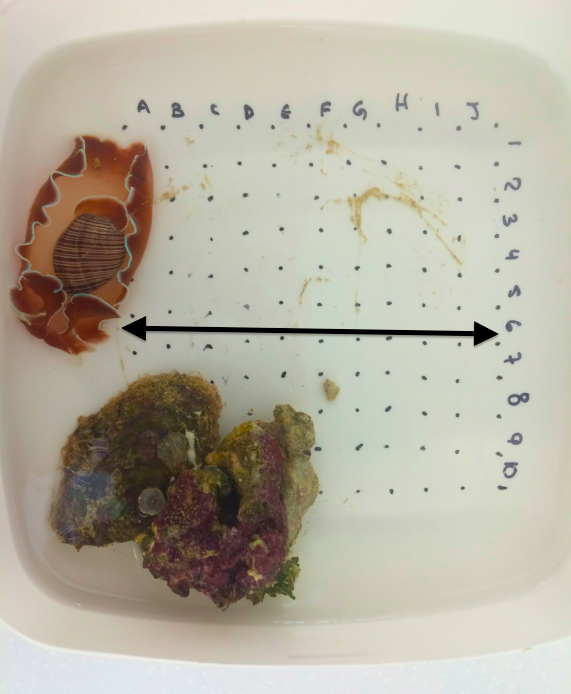EXPERIMENT
Opisthobranchs are hard to study because they tend to be transitory; unlike most marine invertebrates, they cannot be depended upon to be there when you want them (Debelius 1998).
Aim
To observe the rate at which H. physis travels, in the form of crawling, with and without touch.
Hypothesis
H. physis will crawl at a faster rate with touch: gently poking at the rear end of the species.
Method
One species of H. physis was removed from the talk and placed in a square, plastic container with seawater and bits of rubble (Figure 10). The container was labeled to mark out a 1x1cm grid. The H. physis was placed at one end of the container. Once released, H. physis would crawl immediately, and so the timer started to measure how many seconds it took to travel from one end of the container to the other.
H. physis was placed under two conditions:
- Control - allowing the snail to crawl from one end of the container to the other without interference
- Experimental - allowing the snail to crawl from one end of the container to the other with interference, (gently poking its rear end with an index finger, approximately every second)
Both the control and experimental conditions were repeated 5 times. Times were recorded.
 Figure 10. Experimental set-up to measure rate of crawling of H. physis
Figure 10. Experimental set-up to measure rate of crawling of H. physis
Results
An unpaired t-test revealed a p-value of 0.0010. This indicates that the difference is extremely statistically significant. The mean speed that Hydatina physics travelled was 12.9700 seconds per centimetre, while the mean speed with an interference, or touch, was 8.2625 seconds per centimetre.
Intermediate values used in calculations:
- t = 5.4286
- df = 7
- Standard error of difference = 0.867
Table 2. The mean, standard deviation and standard error for the speed travelled by H. physis under a control and experimental condition

Discussion
It can be seen that H. physis increased its rate of movement (in this case, rate of crawling), in the presence of an interference in the form of gentle poking at its rear. As this experiment simulated the presence of a potential predator in pursuit of the snail, the H. physis moved quicker as a response to flee from the event in which the disturbance was happening.
This study demonstrates that when in danger, even very slow moving animals like snails flee by responding immediately to stimuli that may present potential harm.
Results for this experiment were extremely significant (p=0.0010). However, the study is limited due to the small sample size of only one Hydatina physis. A larger sample size would be required to increase the reliability of this study. Also, a larger sample size would allow a wider range of study for H. physis when investigating its movement and predator-prey interactions. |